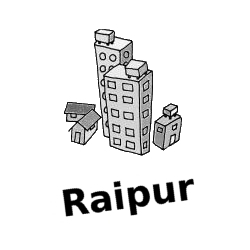Executive Summary
| Disclaimer: Links within the texts to additional information, concepts and tools are SSWM editor’s inputs and might not represent the view or practices of GIZ. |
Introduction
Raipur is the capital city of the recently formed state of Chhattisgarh in November 2000 (formerly part of Madhya Pradesh) in central India. The city is administered by the Raipur Municipal Corporation (RMC). With a population of 1 million (GOI 2011), the city sprawls across 188 km2 and consists of 41 villages. Traditionally, Raipur's economy has been based on agricultural-processing and sawmilling, serving as a regional hub for trade and commerce for a variety of local agricultural and forest products. Today Raipur is an important regional, commercial and industrial destination for coal, power, steel and aluminium industries.Raipur is the largest market of steel and iron in India and among the richest cities of India. Raipur has witnessed a high growth rate in population, which has not been matched with a corresponding sanitation infrastructure (RMC et al. 2011).
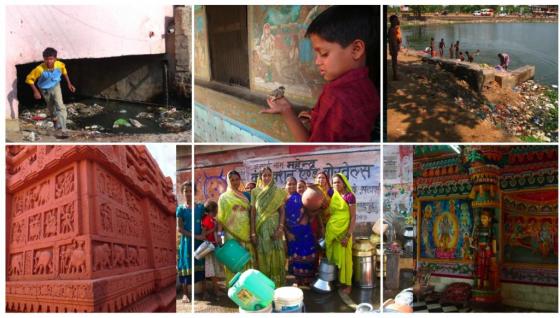
The city of Raipur. Source: RMC et al. (2011)
Raipur at a Glance
Total population in 2011 | 1.1 million (11.2 lakhs) (GOI 2011) |
Total area | 226 km2 |
Area covered under corporation | 142 km2 |
Annual growth projected | 1.8 million (2021); 4.1 million (2041) |
Number of Wards | 70 |
Raipur Ranking Based on NUSP Output Indicators
According to the National Award Scheme for Sanitation for Indian Cities in 2009/2010 under the NUSP, the city of Raipur was ranked at No. 274 with a total score of 30.74. Subsequently it was accorded the lowest rating category.
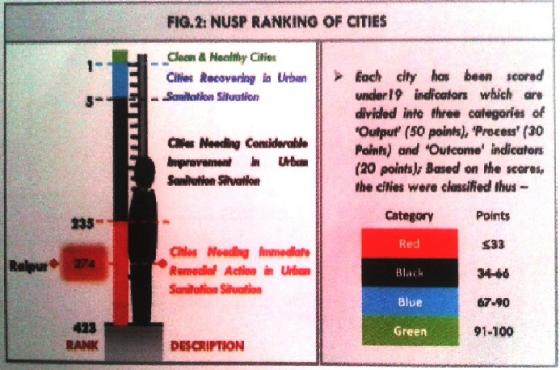
Raipur’s City Sanitation Ranking in 2009-2010 under the NUSP. Source: RMC et al. (2011)
The Role of GIZ in Support of the NUSP
GIZ is currently supporting the Ministry of Urban Development of India (MoUD) in the implementation of the NUSP in Raipur.
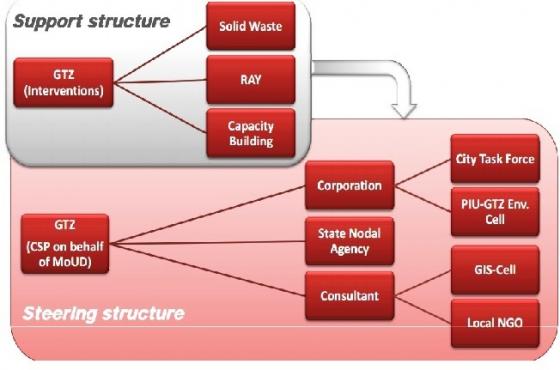
Steering and support structure of the GIZ to the NUSP implementation. Source: WALTHER (2010)
Accordingly, the goals of the NUSP were linked with key issues to be addressed with respect to the water and sanitation infrastructure that are described below. Raipur faces major challenges to preserve the more than 150 lakes and water bodies, which are blessed with pollution through the discharge of untreated wastewater. Other pertinent issues include solid waste management, wastewater and septage management (see also wastewater treatment), lack of fiscal and institutional structures (see also creating an enabling environment in wastewater treatment, financing).
Key Issues Identified in the City Sanitation Plan
(Adapted from GIZ 2011, City level strategy)
The CSP identified certain immediate and long-term recommendations for addressing the key issues and linked those recommendations to an action plan. Below is a list of the key issues as identified in the Raipur CSP.
Key Issue 1: Inadequate and deficiently designed, operated & managed individual and community toilets in the urban poor areas resulting in open defecation and severe health impacts
Rationale for issue identification: A total of 57% of the urban poor population in the city defecates in the open. There is one toilet seat for every 460 urban poor users as compared to the national norms of 1 toilet seat per 50 users. The toilets designed are neither gender sensitive nor handicapped nor elderly users friendly (see also access to water and sanitation, development issues, socio-cultural issues, invalid link).
Recommendations as per CSP: An immediate recommendation is to invite an expression of interest for the design, rehabilitation and up gradation of the existing toilet facilities on a Rehabilitate, Operate and Transfer (ROT) basis on a Public-Private-People Participation (PPPP) mode along with the initiation of a ‘mobile toilet’ pilot project (see also implementation support tools). Next, based on findings of the pre-feasibility and the feasibility study (see also exploring tools), the CSP recommends formulation of two Detailed Project Report’s (DPR): one for the rehabilitative and up-gradation works of toilets and another for construction works of new toilets (see also sanitation systems).
Key Issue 2: Indiscriminate dumping of solid waste in open areas and storm water drains and unscientific management of the dump sites receiving the waste from the entire city and lack of treatment and ultimate scientific disposal
Rationale for issue identification:
Only 8% of the city population is served with door to door collection of solid waste and 7% of the entire population still resort to open dumping of waste which are ultimately crowding the excessive lengths of open, uncovered drains running through the city during the rainy season. The number of dumper placers and tipper trucks required for the existing population is 39 and 60 respectively. However, Raipur Municipal Corporation (RMC) is in possession of only 7 dumper placers and 21 tipper trucks, which is not sufficient for the service delivery. Raipur also lacks scientific engineered landfills and there is an imminent threat of groundwater contamination through the leachate produced from the untreated solid waste (see also water source protection, pathogens and contaminants).

Overflowing solid waste bin (left) and indiscriminate dumping of solid waste in the open drains (right). Source: GIZ (2012)
Recommendations as per CSP: Ensuring that the tender process for the approved Solid Waste Management DPR is finalised with immediate effect to initiate the processes of segregation at source, door to door collection, secondary collection, transport, treatment and disposal in a planned manner (see also solid waste and creating an enabling environment in wastewater collection). Providing the bins for storage at source to all low-income group settlements and all slum level settlements for free, and additionally subsidise the bins for the middle-income group settlements (see also financing). Coordination with the storm water management department should take place to ensure covering of storm water drains and providing them with grates to obstruct the solid waste flow (see also storm water management, channels and drains).
Key Issue 3: Higher risk due to improper septic tanks and septage management leading to contamination of water bodies/water supply distribution system and incidences of water borne diseases
Rationale for issue identification: Roughly 54% of the properties are connected to unscientifically designed septic tanks, which do not adhere to the CPHEEO guidelines and therefore overflow into the open drainage channels ultimately draining into the natural water bodies and/or polluting the groundwater (see also water pollution, groundwater sources, invalid link). Also only 2 suction lorries are available where 120 suction lorries are required to be pressed into service to empty the septic tanks once annually. Currently there is no official designated site available for the disposal and the septage management is informal with a high risk of occupational health hazards (see also invalid link). The water quality samples in the distribution system show abnormal levels of E. coli (EHEC) contamination along with the presence of nitrate in higher concentration in the drinking water (compared to the trace amounts found in the treated water) indicating the ingress of pollutants due to septage overflow in the distribution system (see also pathogens and contaminants). Since the water supply lines run along the road side drains, the drain water may find its way into the drinking water pipes there by contaminating the water giving rise to water borne diseases.
Recommendations as per CSP: A pre-feasibility survey to provide all information about existing septic tanks and a detailed ground water quality mapping exercise to understand the magnitude of ground water pollution in Raipur city owing to septage overflow (see also exploring tools, groundwater sources).
Key Issue 4: The coverage of centralised sewer network in Raipur is insufficient and the willingness of households to get connected low
Rationale for issue identification: Only 11% of the urban poor are connected to the city sewer network (see conventional sewers) while the remaining 89% resort to open drains or open areas for wastewater disposal. At the city level, about 43% of the population in the city lacks any system of disposal of the sewage generated. There is however no legal arrangement on state or on city level to either enforce the connectivity of households nor any provision for incentives and frameworks to motivate the citizens to do the same (see also 1669-creating policies and legal framework in wastewater collection], invalid link, demand creation tools). The current sewer system drains towards the North where two treatment plants are located. Consequently the wastewater from the southern belt is to be pumped over a ridge, which forms the centre of Raipur city. Due to the topography five pumping stations are required in the South and West to pump wastewater over the ridge and none of the pumping stations is frequently operated at the present.
Recommendations as per CSP: Inclusion of centralised and decentralised systems for the city with the vision of efficient and sustainable management (see also semi-centralised drinking water treatments and point of use water treatment). The centre of Raipur city is located on a plateau, which provides a natural gradient that shall be considered along with the population density to strategise the development of sewerage system.
Key Issue 5: The existing sewage treatment system consisting of 7 oxidation ponds is defunct and the total sewage generated in the city is untreated
Rationale for issue identification: The treatment system of the city comprises of seven oxidation ponds (see aerated ponds and waste stabilisation ponds) divided between two different sewage treatment systems (STPs), all of them are dysfunctional due to want of operation and maintenance (O&M) and/or financial reasons. The entire city sewage generated (about 3.7 million litres per day) remains untreated. The electrical connection to the pumping stations has been withdrawn (non-payment of dues since 1997) resulting in their dysfunction culminating in the backflow of sewage to storm water drains and hence leading to pollution. This in turn also renders the oxidation ponds defunct since the waste does not reach them.
Recommendations as per CSP: Immediate recommendations include awarding contract of operation and maintenance (O&M) of the pumping stations and the existing STPs to a Private Service Provider (PSP) on ROT basis (see also invalid link, project design). This shall be implemented only in the city core area and the inner ring area expanding over the existing sewer network, i.e. in the wards located on the ridge. The outer ring area and the peripheral areas shall be investigated for the suitability of technologies in the decentralised systems or onsite solution (see point of use water treatment, exploring tools) and maybe integrated into the centralised system at a later stage.
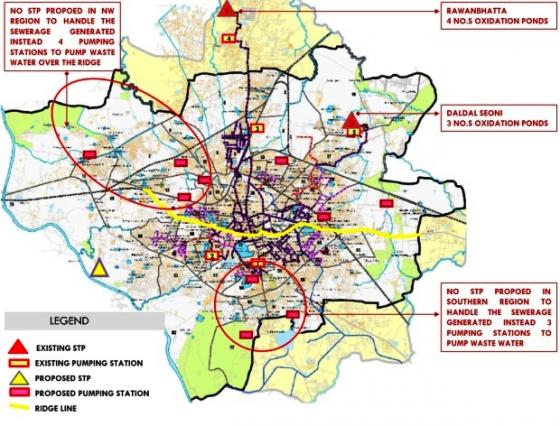
Location of existing and proposed sewage treatment systems and problem areas. Source: GIZ (2011, City Level Strategy)
Key Issue 6: Poor maintenance and non-integration of the available storm water drainage network renders it underutilised leading to a considerable number of water logging areas and hence unhealthy conditions
Rationale for issue identification: The natural drains in Raipur are low in capacity, insufficiently graded and choked due to the indiscriminate dumping of solid waste (see also open channels and drains). Constructions have been executed adjacent to most of the drains reducing the chances of widening them resulting in 29 flood prone areas in the city. In some areas there is no proper outlet of storm water to the adjacent roadside primary drains; some other areas are flooded for 3-4 months during rainy season.
Recommendations as per CSP: Facilitating and ensuring that the approval process for the Storm Water DPR is finalised with immediate effect to initiate the tender process. Coordination with the sewerage and solid waste management department to prioritise the activity of prevention of indiscriminate dumping of solid waste and wastewater discharge into the storm water drains (see also creating an enabling environment and awareness raising in wastewater collection). Further, integrating lakes into the storm water drainage system by converting them into rainwater and storm water harvesting structures (see also stormwater management, retention basin, precipitation harvesting).
Key Issue 7: Sub-standard quality of water supplied or accessed in several areas in the city
Rationale for issue identification: The water quality samples in the distribution system shows abnormal levels of E. coli contamination as high as 2400 per 100 ml (Most Probable Number) (see also water quality testing). It is reported that there were 627 cases of water borne diseases in the city as a result of poor sanitation and unhygienic conditions (see also invalid link). The stand-posts and hand pumps are located very close to the open drains and in some cases the stand-posts are laid in the open drains causing contamination of the drinking water.
Recommendations as per CSP: An immediate recommendation is to conduct an assessment study to determine and map the intersection points/locations of water supply network and sewer or drainage network. Locations where water supply pipes are in close proximity to sewer pipes are in conflict with the CPHEEO Manual for water supply. Similarly mapping the locations of stand posts and hand pumps located in the sewer/open drains or in close proximity to the sewer/open drains is also recommended (see also exploring tools).
Key Issue 8: The existing Institutional and Governance Framework of RMC is not equipped adequately to administer the sanitation development and management services
Rationale for issue identification: The present organisational structure does not conform to the service requirements. Positions of Superintending (all), Executive (50%) and Assistant Engineers (35%) are vacant. The short tenure of Municipal Commissioner (6 months to 3 years), notwithstanding the long-term nature of urban development projects and high frequency of transfers in the city management’s positions adversely affects the continuity and local accountability. The Public Health and Engineering Department and Public Works Department lack adequate support staff to operate and manage the existing system of sanitation services and moreover are overloaded with several varying nature of tasks cutting across different sectors of sanitation. There is lack of designated environmental manager in addition to the non-availability of the State Environmental Policy for environmental guidelines and regulations. Lack of staff for conservation of water bodies, staff training, knowledge management and contractor management as well as the fact that the city does not allocate financial resources for capacity building, has no Capacity Enhancement & Development Strategy makes the situation grim.
Recommendations as per CSP: Organisational restructuring as in the figure below (see also invalid link, invalid link, invalid link, invalid link).
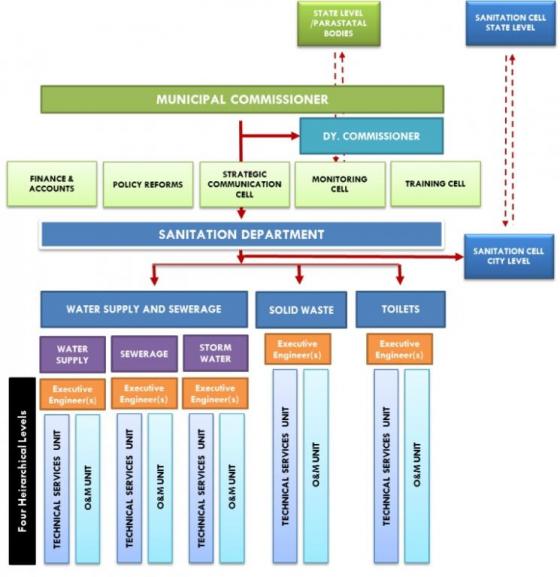
Recommended institutional and governance structure for RMC. Source: GIZ (2011, City Level Strategy)
Key Issue 9: Existing financial management system doesn’t meet the demands of the current and future sanitation requirements
Rationale for issue identification: On paper, Chhattisgarh State has initiated the implementation of Municipal Model Law partially but it has only shifted the city planning and service delivery to local government and has not matched the functions with appropriate fiscal powers. There are insufficient local financial resources. The financial analysis for the period 2004 to 2010 reveals that the revenue expenditure of RMC in all the years is more than the revenue income. Lack of administrative procedures that ensure financial data flow and reporting, absence of internal and external controls and absence of cost-effective and revenue-generating mechanisms is evident.
Recommendations as per CSP: Reengineering the business processes of the Finance and Accounts Department of RMC, implementing Double Entry Accrual Accounting System (DEAAS) in line with the recommendation of the 11th Finance Commission, adopt accounting and budgetary standards as per the directive of Audit & Accounts Department (see also financing, goverment contributions, invalid link).
Selected Interventions by GIZ for CSP Implementation
Some of the after effects of the CSP with respect to interventions undertaken by GIZ to address those key issues are discussed now.
Decentralised treatment system for waste water treatment in the catchment of an urban pond, the Bandhwa Talab
(Adapted from GIZ 2011, Decentralised treatment system)
Location of the intervention: Bandhwa Talab (pond)
Number of beneficiaries (No. of people in catchment area): 950
Rationale of the selection:
The Bandhwa Talab serves as a catchment area for disposal of wastewater. It was identified that the project area consists of roughly 950 residents, including several small shops, one major temple and a school (approx. 400 pupils). A total of 100 m3 per dayof wastewater is discharged intothe Bandhwa Talab of which domestic wastewater discharged through the drainage system is 60%. Hence the need for a treatment system to counter this disposal menace forms the core of the initiative.

The present status of the urban pond Bandhwa Talab (left) and discharge of untreated waste water (right). Source: CDD (2012)
Objectives: The initiative aims to develop a technical-scientific concept of a decentralised wastewater treatment system attached to an urban water body (see also on site storage and treatments, sanitation systems, invalid link, lakes, water pollution). It will have a closer look on septic tanks, the ecological integration of the treatment facility into the lake premises, phosphorus elimination to stop eutrophication and the educational value of the decentralised treatment pilot project. The minimum objective is to remove faecal contaminated wastewater from the storm water drains (see open channels and drains) and to stop the discharge of untreated wastewater into the water body to ensure public health and improve environmental protection (see also environmental issues, invalid link). Other objectives include lake water management and preparation of schematic maps and integration of the collected sanitation properties into a GIS based property database (see also exploring tools).
Current approach:
The first step included delimitation of the catchment area discharging into Bandhwa Talab according to the connectivity of the houses to the storm water drainage network. Following that, a survey was done to reveal the existing on-site sanitation infrastructure within the catchment area. Next, a study of lake properties was conducted such as inflow and outflow structures, depth profile, water quality analysis and estimation of the water balance and assessments of the wastewater quantity discharging into Bandhwa Talab were made (see also water resource assessment). Analysis was carried out of the subsequent wastewater composition discharging into Bandhwa Talab to derive design parameter of a decentralised treatment system. According to the collected primary and secondary data, three wastewater disposal scenarios were proposed.
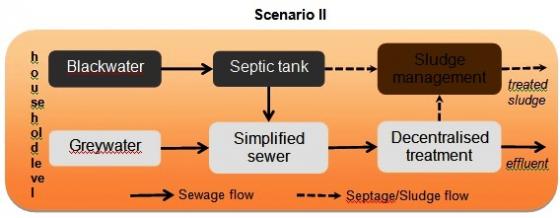
The popular scenario up for selection for implementation of the DTS project at Bandhwa Lake. Source: GIZ (2011, Decentralised treatment system)
Currently scenario II (see figure) is the preferred scenario for implementation. After literature review a set of treatment technologies were identified considering the existing institutional arrangements, economical and environmental aspects, removal efficiency and land availability, however currently the exact decentralised treatment system (DTS) technology to be adopted has not been identified (see also sanitation systems, on site storage and treatments, septic tank, sludge treatment, economic tools, creating an enabling environment in wastewater treatment).
Next steps: After successful implementation of the DTS unit at Bandhwa Talab (based on after-implementation outputs like DPR’s, meeting the legal water standards (see standards in water supply) for inflow and outflow of wastewater, integration of the system into lake environment, etc.), the plan is to upgrade and upscale the same technology for other water bodies in Raipur. Integration with ongoing pilots of GIZ such as community led sanitation planning methodology is part of up-scaling packages. Further, strengthening of the institutional system and other recommendations of the CSP document feed into the lessons learnt in the up-scaling model.
Review of existing Sewerage System in Raipur
(Adapted from GIZ 2011, Review of existing Sewerage System)
Context of the intervention: Functioning sewerage systems are beset with functional deficiencies such as system overload, inadequate flow, diluted sewage, treatment process mismatch and other related operational issues (see sanitation systems, conventional sewers, sewers). This necessitates the need for assessment of the status of existing sewerage system (components such as sewage characteristics, flow regime, hydraulics of collection system and trunk sewers and treatment processes in the sewage treatment plants), prior to new investments. Especially in case of Raipur, the extent of coverage and usage of the sewer network, the status of the pumping stations and the functionality of the oxidation ponds (see aerated ponds and waste stabilisation ponds) (as outlined in Key Issue 4 and Key Issue 5) all need this intervention.
Objective: Review of entire sewerage system of Raipur, including the potential augmentation works within the core of the city (old sewer network) along with understanding the existing and upcoming sewerage system and defining actions in order to rehabilitate and operate the existing system.
Approach: Proposed DPR’s for the city were reviewed for its completeness to handle city requirements and a survey of the main sewer was undertaken. Existing charts, flow diagrams, maps and L sections were used to plan for surveying the main sewer line and a survey team was intermittently accompanied by engineers from RMC and Public Health Engineering Department. Depending upon the condition, manholes were cleaned and pried open to measure silt level, invert level, sewer dimension and sewer length. Flow measurements were made wherever flow was seen. Closed-circuit television (CCTV) cameras are proposed to survey sections where manholes are inaccessible such as heavily tarred roads, under railway lines etc. Photo documentation was undertaken. Longitudinal topographical drawings were prepared. Finally existing drawings, plans and sections were converted to standard GIS representations (see also exploring tools).
Output: A report on the rehabilitation process of the old sewerage system and its adequacy for the 2041 population needs as well as immediate actions, recommendations for integration into the newly planned system.
Next Steps: The connectivity of onsite sanitation facilities in selected urban poor areas and the possibility of connecting the slum pockets to the existing sewerage system will be critically examined based on secondary information. Connectivity in the catchment to the system will be examined and verified through flow estimations. The technical feasibility of laying sewers under Slum Networking Project and of connecting the slums laying on the sewer belt to the rehabilitated network will be undertaken. Energy efficiency audits and lifecycle assessments will be performed on existing machinery such as pumps etc. The oxidation ponds will be rehabilitated and integrated. Support will be provided to RMC in the next step of bidding process for appointment of operator to undertake, project management consultancy of rehabilitation activities, O&M of sewerage system for a set period as defined by RMC.
E-Disha Newsletter July 2012
City Level Strategy Raipur. City Sanitation Plan for Raipur
Decentralised treatment system for wastewater treatment in the catchment of an urban pond, the Bandhwa Talab, Raipur
Review of existing Sewerage System in Raipur
City Sanitation Plan for Raipur
This Brochure is a succinct overview of the City Sanitation Plan for City of Raipur in order to recognise the stress areas in the sanitation sector and establish priorities in the intervention areas along the defined strategic guidelines.
RMC GIZ CDD (2011): City Sanitation Plan for Raipur. Raipur: Municipal Corporation Raipur in cooperation with GIZ and Consortium for Dissemination of DEWATS URL [Accessed: 06.11.2012]GTZ Support - MoUD Workshop on the preparation of City Sanitation Plans
A short presentation about the former GTZ, now GIZ support to the Indian National Urban Sanitation Policy. Topics: the vision of City Sanitation Plans, key objectives for GTZ, steering and support structure, current status, major obstacles.
WALTHER, D. (2010): GTZ Support - MoUD Workshop on the preparation of City Sanitation Plans. Eschborn: Deutsche Gesellschaft fuer Internationale Zusammenarbeit (GIZ) URL [Accessed: 31.10.2012]City Sanitation Plan for Raipur
This Brochure is a succinct overview of the City Sanitation Plan for City of Raipur in order to recognise the stress areas in the sanitation sector and establish priorities in the intervention areas along the defined strategic guidelines.
RMC GIZ CDD (2011): City Sanitation Plan for Raipur. Raipur: Municipal Corporation Raipur in cooperation with GIZ and Consortium for Dissemination of DEWATS URL [Accessed: 06.11.2012]Annexures City Sanitation Plan for Raipur
The annexures of the City Sanitation Plan for Raipur provide extensive supplements.
RMC ; GIZ ; CDD (2011): Annexures City Sanitation Plan for Raipur. Raipur: Municipal Corporation Raipur in cooperation with GIZ and Consortium for Dissemination of DEWATS URL [Accessed: 21.11.2012]GIZ Support
A short presentation about the GIZ support to the Indian National Urban Sanitation Policy. Topics: process, national urban information scheme, interpretation boundaries, 5 strategic dimensions, current status.
WALTHER, D. (2011): GIZ Support. Eschborn: Deutsche Gesellschaft fuer Internationale Zusammenarbeit (GIZ)http://www.indiawaterportal.org/
This website gives information on city level actions going on in various cities of India that have been undertaken within the umbrella of City Sanitation Plans (CSPs) under the National Urban Sanitation Policy (NUSP) since the year 2008.
http://forum.susana.org/
This website is a discussion forum and information portal giving for all kinds of topics relevant to sustainable sanitation practices and technologies. This link goes to the topic “Conceptual Design of a Decentalized Treatment Concept in Raipur, India”.
http://www.urbanindia.nic.in/
This website is the official website of the Ministry of Urban Development of India and a mouthpiece to all the information regarding the National Urban Sanitation Policy of India.

